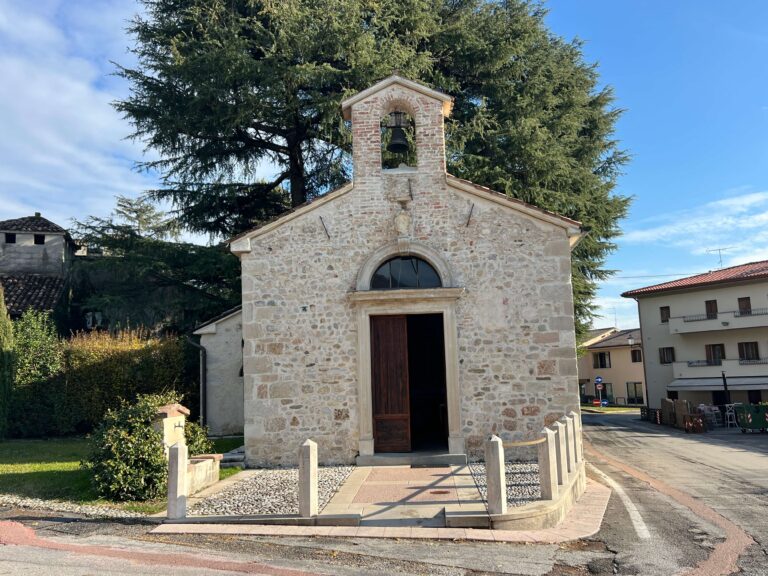ARTISTS’ ROADS
LE VIE DEGLI ARTISTI
watch the videos at the bottom of the page!
Farra di Soligo
It was 1918.
An Italian shell struck the small church of Santa Maria Nova in Soligo. Part of a wall collapsed. Patches of plaster fell away.
A tragedy.
But frescoes emerged. Fourteenth-century frescoes.
A coat of arms tells us that this church was linked to the da Camino family.
Do you remember the good Gherardo, mentioned by Dante?
Either your speech deceives me or would tempt me,”
he answered then, “for you, whose speech is Tuscan,
seem to know nothing of the good Gherardo.
There is no other name by which I know him,
unless I speak of him as Gaia’s father.
God be with you; I come with you no farther.
He was born right here among these hills, in 1240.
He had both legitimate and natural children.
Among the latter was Giacomo, lord of these lands.
And to his son, Rizzardo da Soligo, we owe the founding of this church in 1350. It was built within his residence. And it was meant as his burial place.
A gesture of faith. A good work to expiate sin. A way to remember relatives who had died of plague.
There were already eight churches in the area, three dedicated to Mary. Hence the name Santa Maria NOVA, that is new.
Rizzardo da Soligo endowed the church with property so that its income would support a priest.
He affiliated it with the Order of the Knights of Jerusalem, later known as the Knights of Malta, who were present in the Castle of San Salvatore, held by the Collalto family.
Over seven centuries, the church underwent many changes. Three arches were added to separate the presbytery. The ceiling was raised. And then came the war damage.
Its walls are a precious book for us to leaf through, or rather, to virtually scrape, as one would an ancient manuscript.
The most recent intervention dates to 1489. It erased an earlier work with the same subject, painted 140 years before.
Thirty years earlier, in the 1460s, a painter active in Serravalle had worked here, the so-called Master of the Galletti Chapel.
In 1450, Giovanni Antonio da Meschio painted a delicate image of Saint Lucy.
In 1362, two painters worked on the north wall.
One painted a sort of triptych, and a Saint Anthony Abbot.
The other painted five saints and added an inscription bearing the date, the name of the patron, Armerico degli Azzoni, a grandson of Rizzardo da Soligo.
Spurs, greaves, daggers and baselards speak of a family tied to the military profession.
Their clothing follows the fashion of 1340 with wide, rounded necklines.
Heavy silks with decoration. Vivid colours. Gilt buttons. Braided trims. Fur linings. Long cuffs. These are luxurious garments. They honour the saints and affirm the status of the da Soligo family, depicted at their feet.
These are recognisable saints but they live in the time of men.
The oldest paintings, created just after 1350, are found behind the altar, correctly oriented to the east.
What do we know of this painter, so skilled in rendering volume and expression of the figures?
We don’t know his name.
But he was familiar with Giotto’s work, as interpreted by the Rimini school, in the Chapel of San Salvatore at the nearby Castle of Susegana.
A remarkable early fourteenth-century cycle, destroyed by Italian bombs in 1918.
The same war took away and revealed.
To step inside this small church is to grasp how refined the artistic culture was in these hills seven hundred years ago. A land that is not only beautiful in landscape.
It is also steeped in history.
MORE EXPERIENCES!
In giro per affreschi dal Trecento al Novecento!
- La pieve di San Pietro di Felletto.
- L’oratorio di Sant’Urbano a Godega.
- Guido Cadorin nella parrocchiale di Moriago.
- Giovanni Zanzotto nella parrocchiale di Mosnigo.
MULTIMEDIAL MAP: “ARTISTS’ ROADS – LE VIE DEGLI ARTISTI- EN”!

